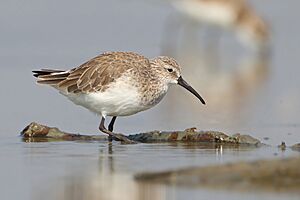Curlew sandpiper facts for kids
Quick facts for kids Curlew sandpiper |
|
|---|---|
 |
|
| Non-breeding plumage | |
 |
|
| Breeding plumage | |
| Conservation status | |
| Scientific classification | |
| Genus: |
Calidris
|
| Species: |
ferruginea
|
 |
|
| Synonyms | |
|
Erolia ferruginea Vieillot, 1816 |
|
The curlew sandpiper (Calidris ferruginea) is a small wader bird. It breeds in the very cold Arctic region of Siberia.
These birds are strong migrators. They fly long distances to spend winter mainly in Africa. They also travel to south and southeast Asia, Australia, and New Zealand. Sometimes, they wander off course and end up in North America.
Contents
About the Curlew Sandpiper's Name
Scientists give every animal a special two-part name. This helps everyone know exactly which animal they are talking about. The curlew sandpiper was first described in 1763 by a Danish writer named Erik Pontoppidan. He gave it the name Tringa ferrugineus.
Today, it is part of a group of 23 other sandpipers in the genus Calidris. This group name comes from an old Greek word for grey waterside birds. The second part of its name, ferruginea, is Latin for "iron rust." This describes its reddish-brown color during breeding season.
What Does a Curlew Sandpiper Look Like?
Curlew sandpipers are small wading birds. They look a bit like dunlins, but they have some key differences. They have a longer beak that curves downwards. Their neck and legs are also longer. You can easily spot their white rump when they fly.
These birds are about 18 to 23 centimeters (7 to 9 inches) long. They weigh between 44 and 117 grams (1.5 to 4 ounces). Their wingspan is about 38 to 41 centimeters (15 to 16 inches).
When they are ready to breed, their upper parts are dark grey with patterns. Their belly and chest turn a beautiful brick-red color. In winter, they change to a pale grey on top and white underneath. They also have a clear white stripe above their eye. Young birds have a grey and brown back. Their belly is white, and their chest has a peachy color.
Where Do Curlew Sandpipers Live?
The curlew sandpiper breeds in the Siberian Arctic. This area stretches from the Yamal Peninsula to the Kolyuchin Bay.
How Do Curlew Sandpipers Behave?
These birds love to be in groups. They often form large flocks with other wading birds, especially dunlins. Even though they breed far east, they often pass through western Europe. This is likely because their migration route goes southwest.
Breeding and Raising Chicks
Curlew sandpipers arrive at their breeding grounds in June. They stay until late August. The male bird performs a special aerial dance to attract a mate.
They build their nests near the edge of a marsh or a pool. Sometimes they choose dry spots on the tundra. The female usually lays about 3 to 4 eggs. She lays one egg each day. The female then sits on the eggs to keep them warm. The eggs hatch after about 19 to 20 days. The mother bird takes care of her chicks for about 14 to 16 days.
The success of their breeding depends on the number of lemmings. Lemmings are small rodents that live in the Arctic. In years when there are not many lemmings, predators like the Arctic fox might eat the sandpiper chicks instead.
What Do Curlew Sandpipers Eat?
Curlew sandpipers look for food in soft mud. They search in marshes and along the coast. They mostly pick up food by sight. Their diet mainly consists of insects and other small creatures without backbones, called invertebrates.
What is the Curlew Sandpiper's Status?
The number of curlew sandpipers has been decreasing. For example, in South Africa, their numbers dropped by 40% between 1975 and 2009. A similar drop has been seen in Australia. Scientists think this might be linked to effects of global warming in their breeding areas.
Even though they live across a very large area, their population is getting smaller. Because of this, the International Union for Conservation of Nature (IUCN) has listed them as "Near-threatened." This means they could become endangered if their numbers keep falling. The curlew sandpiper is also protected by an agreement called AEWA. This agreement helps conserve migratory waterbirds in Africa and Eurasia.



